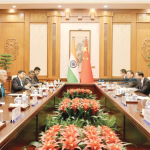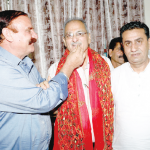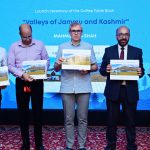Much has been already written and said about works and teachings of the two patron saints of Kashmir Sheikh Noor- ud Din Noori (RA) and Shiekh Hamza Makhdoom (RA). It is universally accepted that these two personalities promoted the doctrine of genuine mysticism and captivated it into the hearts of the people, called them to the true religion and filled the hearts with the light of monotheism, faith and devotion. If the former founded the local sect of Reshi order, the later one cultivated the general Sufism. The two stood taller among other mystic personalities of this land. It would not be wrong to say that the entire Kashmir mysticism revolved around teachings of these two great Personalities. The first one lived in 14th century AD and founded the Reshi order of mysticism while the later one lived in 16th century AD and safe guarded the true message of Sufism and its teachings. In simple terms we can say that the first one struggled for foundation and cultivation of Sufism called in local terms Reshiyeet, the later one protected and safe guarded the mysticism from falling prey to non Islamic teachings.
In fact centuries have passed when these two grand mystic personalities lived here but the spirit of mysticism they cultivated and promoted among kashmiries has in no way disappeared anywhere here in Kashmir. One may feel decline in Sufi practices but not in its concept and sprit. The Sufi centers and Khanqahs set by these grand saints always showcase the hustle and bustle of its devotees, in fact when ever Kashmiri feels his pain and grief he would wholeheartedly throng their Khanqahs and shrines and would share his pain with their beloved saints. Indeed he also believes in oneness of God, but considers Sufis, the beloved saints of the GOD, where he makes special prayers and seeks His blessings. These mystic saints, their works, teachings and Sufi miracles which they performed in providing the healings to the deprived kashmiries at respective times are mentioned in greater length in mystic and historic records of this land and there is hardly anything left about them which has not been explored so far. But here I would not repeat their those works and teachings which have already been documented in the mainstream and Sufi literatures of this land , instead of it I would rather here prefer to share certain other curious aspect related to these grand personalities which the people in general hardly are aware about.
Do you know that these saints have also been mentioned in the numismatic records of this land? Although during their lifetimes, they never enjoyed any sort of political or administrative patronage, yet they have been posthumously remembered by the Kashmir administrators, while putting their respective names with their Sufi titles on the special numismatic issues of Kashmir. Archaeologists and numismatists have identified and deciphered several such gold, silver and copper coins which have been posthumously struck in the names of these two celebrated saints of Kashmir. These coins are very rare and pertain to the period of Durrani Dynasity which ruled this land during (1753-1891 AD). These coins are believed to have been struck either by Attah Mohammad Khan a Durrani Governor or by his Master at Kabul Shah Shuja. These are couplet type coins, bear on the obverse a wonderful Persian couplet which reads ‘Sika shud Roshan iz shaie Noor-u-din Reij Az Makhdoom Qutub-ul-Arifeen’ (which means that this coin has got enlightened with the rays of Noor-ud-Din and has been struck by Makhdoom titled as Qutub-ul-Arifeen.). The couplet in simple terms is self explanatory, which means that Kashmir currency has shined with rays of Shiekh Noor un din (RA), but this currency has been struck by Shiekh Hamza Makhdoom, who is tilted on the coins as Qutubul Arifeen (perhaps means the head priest) In spirituals terms this couplet may got more meaning, since I am not any Sufi follower or any Scholar so cannot understand its hidden meaning.
History records that the Mughals in Kashmir were followed by Durrani and it was in 1753 Ahmad Shah Abdali brought Kashmir under Afghan empire and he founded a dynasty known historians as Durrani dynasty. This dynasty ruled Kashmir for about sixty years, with headquarter at Kabul. They appointed their respective governors to administrate Kashmir. Ahmad shah, Suliman shah, Timur Shah, Zaman shah, Mohammad Shah, Shah Shuja, Qasir Shah and Ayiub Shah has been the famous emperors of durrani dynasity. They issued their gold, silver and copper coins from their various mints and Kashmir also formed their permanent mint, where from they issued their Kashmir coins with the mint name Zarb-i- Kashmir. They had wonderful coinages, with interesting couplets displayed on the obverses of their coins and reverses of their coins mention the mint name with date. The posthumous issues of Shiekh Hamza and Shiekh Noor din also bear the wonderful couplet, describing the Status of the two patron saints. The Shiekh Humza Makhdoomi has been tilled here as ‘Qutubul Arifeen’ meaning the head of priests. This is basically a Sufi status given to practicing saints, since I am no longer a Sufi so cannot interpret the term in its proper meaning but Sufis may know better about it.
Numismatic records suggest that W R Rodgers, a British numismatist was the first to identify and decipher these posthumous issues during 20th century. He deciphered several such coins and recorded them in his monumental book ‘The Catalogue of Punjab Museum Lahore’; he has classified few of such coins with their illustrations.Later several other numismatists worked on these coins and documented them in their numismatic literatures. Mohammad Yousuf Taing, the renowned scholar and cultural expert, has also described these coins in kashmeri in an issue of Kashmir encyclopedia published by Jammu and Kashmir academy of art, Culture and languages. More recently I have also in my book on numismatics, ‘Kashmir Coins’ classified one such silver coin which is preserved in the numismatic collection of the Srinagar Museum. These coins, as per numismatic records, are available in gold, silver and copper. One golden ‘Mohur’ (coin) weighing less than 335 grains have also been identified in Punjab Museum Lahore. The silver coins denominated as rupee weighed fewer than 170 grains.
The copper ones weighed under126 grains. The legends on these coins vary from series to series and on copper coins the legend reads ‘Ya Sheikh Ya Makhdoom Jehan’. The reverse of these coins in floral design field gives the mint name and date as Zarbi Kashmir. The coins are dated in Hijra era and are dated between AH 1223 to 1228 which corresponds to the Duranni period. These coins have been struck in Kashmir mint which is learnt to have been setup somewhere near Saraf kadal area of old Srinagar. Historical records suggest that Atta Muhammad Khan was appointed governor of Kashmir in 1804 by his master Shah Shuja in Kabul. In about 1808 he is learnt to have revolted against the Kabul administration and declared himself as an independent king of Kashmir and to gain the public mandate, Khan discarded the tradition of placing emperor’s name on his coins and chose to strike coins in the name of these famous Sufi saints of Kashmir. There are number of copper coins of this series found in various Indian and Pakistani Museums. The SPS Museum at Srinagar in its numismatic collections also housed several such silver and copper coins. These posthumous numismatic issues of these saints clearly speak of their popularity among the local people of Kashmir.
(The writer is an archaeologist and author on Kashmir archaeology and numismatics. Email:[email protected])








